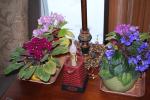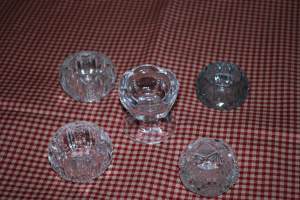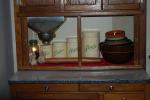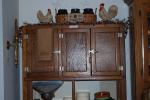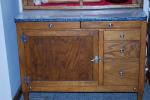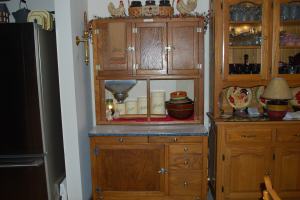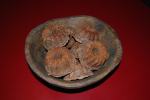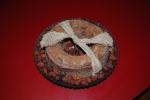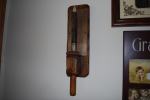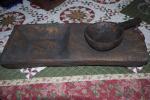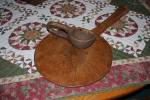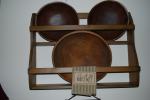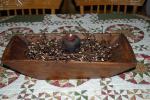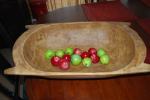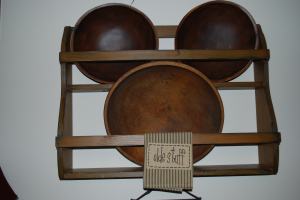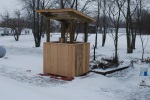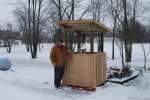REMEMBERING AND RECREATING THE BEST PART OF OUR PAST. This blog is for those of us who like the old days and the old ways. I know you share our love of old things and hope you continue to drop in and visit us here on our Blog. I invite you to share your memories as well.
These are a Few of My Favorite Things

These are a Few of My Favorite Things
Monday, January 31, 2011
Primitive Dry Sink
Adding an antique dry sink to your home is a quick way to give it a vintage look. Whether you love primitives or Victorian design, a dry sink will fit right in.
What is a Dry Sink?
Dry sinks were used to hold the pitcher and wash basin that were standard in any well equipped home. You might find a dry sink in the kitchen or bedroom area, and more than one farmer's wife kept one on the back porch.
The dry sink was a cabinet with a recessed area on top. More expensive dry sinks had these areas lined with copper or other waterproof material. The recessed area kept the water from the pitcher and bowl contained while someone washed up. The dry sink also had storage areas where extra towels and personal items would be kept. Generally there was a hook, bar, or other device to hang up the towel. Dry sinks were often made of pine, but in more affluent homes any wood might be chosen. During the Victorian era, the tops of dry sinks might have been level rather than recessed, and had a slab of marble across the top for the pitcher and basin to rest upon.
Decorating with an Antique Dry Sink
So versatile is this piece of furniture that you can add it to almost any room. It is a nostalgic addition to a large country kitchen, piled high with cookie jars and other collectibles. In a Victorian bedroom it looks just right with a pitcher and bowl, and it can be transformed into a bathroom vanity as well. Other uses for dry sinks are: night stands, side tables and kitchen counters.
The dry sink pictured above is a solid wood reproduction and will be featured for sale in the Persnickety Primitives shop. The piece looks like a well worn Primitive dry sink. It has a covered box built on top that serves as additional storage.
(Research materials taken from: "Love To Know Antiques")
Sunday, January 30, 2011
Sunday Dinner
We have a tradition of getting together as a family every other Sunday afternoon to share a big home cooked meal and family fellowship. It is a time when we come together and share events from the previous days and reconnect. We spend the afternoons watching sports on TV. We have done this for years and it saddens me to think that soon the grandchildren will have lives of their own and the family will find it hard to all be together as we are now. We have an unspoken promise not to bring up any negativity during the meal if at all possible - there is enough of that in our daily lives sometimes anyway. We want to create warm memories of pleasant conversation and good food. My mother started this tradition and when my kids were growing up, we sat around Mom's table and ate her wonderful fried chicken and visited. Once Mom grew older and unable to cook, the tradition was transferred to my house. Mom had her special place at our table. For a while, she would bring her macaroni and cheese dish when she came. She always felt the need to contribute to the meal. Even after she was no longer able to cook, she would bring an angel food cake to share. I miss her sitting at our table. I am trying to be very aware of the blessings of family and realize that I, too will someday have to give up this labor of love. I know my daughter will assume the roll when that time comes. But until that time, Clark and I enjoy watching the family laugh and talk. Even our little dogs are excited on family Sunday. We're all thankful for the blessing of family.
Saturday, January 29, 2011
Vintage Soap Saver
A soap saver was used to preserve and use up every last bit of bar soap. When the bar soap got too small to use on a washboard, the small bits were placed inside of the soap saver and swished through the water to create suds. They were particularly used in the dishwater. They have a "hinged" lid and a small metal ring to secure the basket once closed. These have a very vintage appearance and look like they have seen many wash days. These make an excellent addition to your primitive home decor. Hang them off a hook in your bath or laundry room or on an old washboard for display. Just another way to add vintage charm to your laundry or bath.
Primitive Washboards
Another fun primitive collectible is washboards. Although they are not used for their intended purpose any longer, these primitive antiques are popular as wall decor and are used to decorate walls in laundry rooms, kitchens, family rooms, and any other place where a retro look is desired.
In 1868 the New York Times called washboards "a great American invention" and ran a story about a man taking "a wooden grooved washboard" home to his sister in Germany as a novelty. Yet "it is believed that ribbed wooden scrubbing boards originated in Scandinavia and the manufacture spread to other countries during the 19th century," said Edward Pinto, an expert on domestic objects crafted from wood. Metal washboards were surely a "great American invention". 1833 offers a good clear-cut date in their story. On February 9, 1833, Stephen Rust of Manlius, NY patented a new idea: a "Wash Board" with a piece of "fluted tin, sheet iron, copper or zink". This appears to be the first patent for a metal washboard.
The third picture down is from my collection. It belonged to my late mother-in-law. The bottom picture is an example of a glass washboard, also from my collection. It was manufactured by the National Washboard Company and numbered #512. The wood appears to be either pine or poplar. The fluted or ridged glass side is where the clothes were rubbed after a bar of laundry soap was applied to the wet clothes. The soap bar rested on the shelf above the glass. This is why the company's advertising logo on the "business side" of all washboards is always faded or has vanished altogether. This one is in pretty good condition. This National washboard dates from the early part of the US participation in World War II. Shortly after Pearl Harbor was bombed, the US began metal drives throughout the country to collect scrap metal for use in the war effort. Immediately, companies like National Washboard were unable to obtain galvanized steel, zinc, tin, or brass to make their products. The wood and glass washboard was introduced and become an instant hit with home front homemakers.
One clever way to display the glass washboards is to stand the washboard up on the top of a cupboard and place miniature lights behind it. The soft glow shining through the glass washboard creates a wonderful ambiance in your primitive home. This collection creates a chance to put a piece of history in your home. We will have several primitive washboards and small reproduction washboards for sale in our shop.
Rolling Pins
You will find a rolling pin in almost every kitchen, regardless of the age of the homeowner. In fact, they are a very popular collectible and readily available at flea markets, antique shops and primitive shops. They are somewhat difficult to display but we think we have the perfect solution. The rolling pin rack in the top picture is handmade for us by a local craftsperson and will be for sale in our Persnickety Primitives shop. You will also be able to order it finished in a custom color of your choice. This one is more of a wood tone and we also will have one in the shop that is finished in distressed black. Let's look at a little of the history of rolling pins.
Of course, a rolling pin is a cylindrical food preparation utensil used to shape and flatten dough. Two styles of rolling pins are found; roller and rod. Roller types consist of a thick cylindrical roller with small handles at each end; rod type rolling pins are usually thin tapered batons. Rolling pins of different styles and materials offer advantages over another, as they are used for different tasks in cooking and baking.
ROD: Thin rods typically made of wood around 2-3 cm in diameter. They are used by rolling the rod across the dough using one's palm. The pins may be tapered at one or both ends for more pivot control in certain tasks such as making small pie shells. Most East Asian or French style rolling pins, and the Turkish Oklava are rod style. Although I collect old rolling pins, I usually use a wooden french rod style made by Paula Deen (available at Walmart) for my every day use.
ROLLER: Consists of a thick heavy roller made of a variety of materials around 7-10 cm in diameter with thinner handles which extend through the roller. They are used by grasping the handles and pushing the pin across the dough. Many Western rolling pins are roller types. These are the most common collectible.
Rolling pins come in a variety of sizes and shapes and materials including glass, (ceramic), Acrylic, Bakelite, Copper, Brass, Aluminum, Silicone, wood, stainless steel, marble, and plastic. Some are hollow and are able to be filled with cold or warm water to better roll a desired food. Marble rolling pins are often cooled in a refrigerator for maintaining a cold dough while making puff pastry.
In the top picture, you will notice on the very bottom of the rack, there is a very small rolling pin. My dad brought this home to me when I was about ten years old. A friend of his had whittled it for me. That little rolling pin has flattened many mounds of play dough when I was a child. It is a sentimental keepsake in my collection. We will have several old examples of rolling pins available for sale in the Persnickety Primitives shop. My favorite collectible rolling pins are the older one piece ones. They do not have the rod running through the pin, but instead are carved entirely in one piece. Examples of these are shown in the bottom picture. Whether you are an avid rolling pin collector and just need a way to display them, we have your solution. Or, if you are a beginning rolling pin collector, you can add to your collection from the treasured finds available in the shop.
Friday, January 28, 2011
One of My Favorite Places
Whenever I have to go shopping for groceries, I always manage to stop in to some of my favorite primitive shops. That's why I don't buy groceries in the same town every week. This week I shopped in Mt. Orab, OH so I could stop in and visit my friends at "Kountry Sunshine Primitives". This shop is very unique. It is combined with a Dry Cleaners. It may seem unusual at first, but it sure works! This shop is appropriately named because despite the weather outside, the girls at Kountry Sunshine are faithful to welcome customers with a big smile. I find myself visiting with the girls as much as shopping. There are wonderful finds in every nook and cranny in the shop. You will find many primitive reproductions, some genuine antiques and many unique one-of-a-kind handcrafted items. My kind of shop! I always leave the shop with a smile on my face and a bag of unique finds in my hand. This is one of my "sister shops" in our shopping area.
Thursday, January 27, 2011
Old Hats and Purses
You know, ladies just don't wear hats like they used to. Ladies used to own a hat for almost every occasion and one to match every outfit. I remember the ladies wearing them at church when I was a child, especially at Easter service. To be honest though, I have noticed a "come back" of sorts of hats this winter. Even the news ladies on TV are wearing them. I am not sure if it is more for warmth or for fashion, but they are cuter than a plain scarf which I think shows no personality at all. I, myself, have not been successful at wearing a hat. I think you have to have a "hat face" and I just don't have one. I think the hats pictured above have already served their purpose in the fashion world and are best just left for display. These are some of my collections. The purses on the bottom picture were my grandmother's purses. I don't remember her ever carrying them. Maybe she just liked collecting them as I do. The two larger purses in the top picture are covered with very tiny beads. I do remember seeing ladies carry purses such as these. My friend visited me in honor of our birthdays one year and we each put on a hat and took a "silly picture". Now that's the best idea we have had for them so far! How many of you ladies are wearing hats these days?
Wednesday, January 26, 2011
Old Dolls
The top doll is my "Tiny Tears" doll with the outfit that my grandmother made. The bottom doll was handmade by my grandmother. The head, hands and feet were a kit.
Child-size Furniture and Old Dolls
There is nothing more exciting to a little child than to provide them with furniture sized just for them. The furniture pictured above has been played with by all five of my grandchildren. The little dresser was hand made by a friend of ours. He used wood from a barn over 100 years old that had been torn down. At the time my oldest grandson was two years old. I remember that he walked up to the little dresser that was just his size and asked, "Did you get that for me?" I purchased the little doll bed from a co-worker from Hillsboro, OH. I used an old feather ticking pillow for the "mattress" and put a little handmade quilt over it. The doll is also a precious collectible. When my grandmother passed away, she had the little porcelain doll head and hands tucked in a box in a drawer. I am sure she intended to make it into a doll but never got around to it. I had a friend with sewing talents make it into the doll that I will always treasure. Mamaw loved making and restoring dolls. She would buy old worn out dolls from garage sales and bring them home and wash their hair and bodies. She would put little curlers in their hair and sew a fresh outfit of clothes for them. As her final loving touch, she would name each doll. I remember she had a little doll with a pink taffeta dress she had made sitting on the bed in her guest bedroom that had hair close to the color of mine. She gave that doll my name and I never forgot how special that made me feel. Mamaw brought down a well worn "Chatty Cathy" doll from her attuc that couldn't even talk any more and gave it to my daughter, Keri and told her that maybe she could restore it someday. My last doll was a "Tiny Tears" doll that I received when I was ten years old. I loved that doll because it would drink, cry and wet. After I had my own children, I couldn't figure out why that delighted me so much. I played with that doll until I had worn out the clothes that came with it. Mamaw lovingly took the doll home with her and when she brought it back to me, it had a new outfit complete with panties and bonnet. To this day, I think of Mamaw when I see a worn doll. Mamaw shared her love through those old dolls. I remember that she would also make apple head dolls. She would carefully peel an apple and carve out a face in the apple. She would put the apple on a stick and set it up on the mantle behind the pot bellied wood stove in her living room to dry. After a few weeks, the apple head would dry and shrivle up into a wrinkled little face. She would then take a wire coat hanger and form the basis for a body and then she would go upstairs to her sewing room and make it a perfectly wonderful outfit. I would sit for hours and watch Mamaw work on those dolls. Sometimes she would give me little projects to help with. To this day, I have many dolls in my home. They are little memories of my grandma.
Treasured Shadowbox Collectibles
As you can tell by now, I have a passion for collecting just about anything old. Big items are easy to display, but small collectibles can get lost or become forgotten in boxes or drawers. I like to keep my collectibles out where I can see and enjoy them every day as I pass by them. I distinctly remember the day I put these two shadow box collections together. I was babysitting my two year old grandson, Karson (who is now 15) and got the urge to do something "crafty". I had purchased two shadowbox frames, not really sure how I would use them. I decided to create a theme display in each one. The first one is "The Lady's Dressing Table" and the second one is "Grandma's Sewing Room". The first contains a lady's handkerchief, a coin purse, hair combs, hair pins, Mabelline eye pencil refills, metal curlers, a brooch, white gloves, an old Elgin watch, a locket, a ring and an old advertising brochure. The second contains a paper of snap fasteners, needles, a pair of glasses, an old measuring tape, embroidery thread and hoops, a partially crocheted doiley, thimbles, thread and buttons. Putting these small items together gave each importance and a sense of belonging. Why not go through your boxes and drawers and see what treasures that you may have forgotten. You just might have all you need to create your own treasured shadowbox.
Tuesday, January 25, 2011
What is a Barrister's Bookcase?
To understand what a Barrister's bookcase is, one must first understand what a barrister is. A barrister is a member of one of the two classes of lawyer found in many common law jurisdictions with split legal professions. A barrister requires the use of many law books and may frequently move to new chambers. A specialized form of portable bookcase has thus developed to meet their needs. A barrister's bookcase consists of several separate shelf units that may be stacked together to form a cabinet. An additional plinth and hood complete the piece. When moving chambers, each shelf is carried separately without needing to remove its contents and becomes a carrying-case full of books.
As most high quality bookcases are closed by doors, but also to retain the books when being carried, a barrister's bookcase has glazed doors. As the shelves must still separate it's not possible to provide the usual hinged doors opening sideways and so instead they use and "up and over" mechanism on each shelf. The better quality cases use a metal scissor mechanism inside the shelves to ensure that the doors move in a parallel fashion without skewing and jamming. Many of this style, exported worldwide, were made by the Skandia Furniture Co. of Rockford, Illinois around the beginning of the 20th century.
This style of bookcase was either made in a Dickensian period, or harkens back to the style of such times, so they're most commonly glazed with a leaded light and small panes of glass.
The true barrister's bookcase must be capable of each shelf being carried with a heavy load of books. The more robust examples have folding handles at the ends of each shelf. Modern "decorator" copies of these may look the same, but are often too lightly constructed to be carried whilst loaded, or may even be simply a single fixed case as per a normal bookcase, but with separate doors to each shelf to give the appearance of a barrister's bookcase.
One of the attractions of the barrister's bookcase is that the construction helps to provide a greater degree of protection than many types of bookshelves. The glass doors help to limit the amount of dust that can settle on the books, which will help to keep the book collection in better overall shape. Along with protecting the books from dust, it is also possible to outfit the doors with tempered glass that helps to minimize the impact of sunlight on the spines of the books, effectively helping to keep the color of the bindings from fading.
While antique barrister bookcases can be quite expensive, there are a number of manufacturers that produce replica editions as well as modernized versions at reasonable prices. Some versions are very simple in appearance, and will fitnin well with a number of different decorating themes. It is not unusual for a homeowner to purchase one or more bookcases of this type, trim them with crown molding that is like that used elsewhere in the room, and create a customized storage source for very little cost. Because the bookcase can easily be stacked, it is possible to use the barrister bookcase to create interesting wall units, sofa tables, or even a breakfront for a dining area. Finding different versions of the barrister bookcase is not difficult. Many antique shops will have elegant models for sale. High-end retailers who cater to office and home furnishing needs will also have several models of the barrister bookcase for sale. In addition, it may be possible to locate the ideal barrister bookcase for sale online or at an estate auction.
The barrister's bookcase above is from my own collection. Clark and I inherited the true antique piece from my late stepfather. Instead of books, Clark uses the piece to hold his collection of antique toys and collectibles. It is in excellent condition and holds many memories for our family.
(facts in information taken from Wikipedia, the free encyclopedia)
As most high quality bookcases are closed by doors, but also to retain the books when being carried, a barrister's bookcase has glazed doors. As the shelves must still separate it's not possible to provide the usual hinged doors opening sideways and so instead they use and "up and over" mechanism on each shelf. The better quality cases use a metal scissor mechanism inside the shelves to ensure that the doors move in a parallel fashion without skewing and jamming. Many of this style, exported worldwide, were made by the Skandia Furniture Co. of Rockford, Illinois around the beginning of the 20th century.
This style of bookcase was either made in a Dickensian period, or harkens back to the style of such times, so they're most commonly glazed with a leaded light and small panes of glass.
The true barrister's bookcase must be capable of each shelf being carried with a heavy load of books. The more robust examples have folding handles at the ends of each shelf. Modern "decorator" copies of these may look the same, but are often too lightly constructed to be carried whilst loaded, or may even be simply a single fixed case as per a normal bookcase, but with separate doors to each shelf to give the appearance of a barrister's bookcase.
One of the attractions of the barrister's bookcase is that the construction helps to provide a greater degree of protection than many types of bookshelves. The glass doors help to limit the amount of dust that can settle on the books, which will help to keep the book collection in better overall shape. Along with protecting the books from dust, it is also possible to outfit the doors with tempered glass that helps to minimize the impact of sunlight on the spines of the books, effectively helping to keep the color of the bindings from fading.
While antique barrister bookcases can be quite expensive, there are a number of manufacturers that produce replica editions as well as modernized versions at reasonable prices. Some versions are very simple in appearance, and will fitnin well with a number of different decorating themes. It is not unusual for a homeowner to purchase one or more bookcases of this type, trim them with crown molding that is like that used elsewhere in the room, and create a customized storage source for very little cost. Because the bookcase can easily be stacked, it is possible to use the barrister bookcase to create interesting wall units, sofa tables, or even a breakfront for a dining area. Finding different versions of the barrister bookcase is not difficult. Many antique shops will have elegant models for sale. High-end retailers who cater to office and home furnishing needs will also have several models of the barrister bookcase for sale. In addition, it may be possible to locate the ideal barrister bookcase for sale online or at an estate auction.
The barrister's bookcase above is from my own collection. Clark and I inherited the true antique piece from my late stepfather. Instead of books, Clark uses the piece to hold his collection of antique toys and collectibles. It is in excellent condition and holds many memories for our family.
(facts in information taken from Wikipedia, the free encyclopedia)
The Silence of Winter-Time to Plan for Spring
There is nothing more beautiful than freshly fallen snow. This picture was taken from the door of my sunroom. We have seen a lot of snow this winter already. Aside from the obvious beauty, it is a time for planning or finishing those projects that we have laid aside. I know I keep promising myself that I will finish a sampler that has been waiting for me for longer than I care to admit. I have even bought the frame and mat for my "masterpiece", but my unfinished project is still tucked neatly in my sewing basket. That doesn't even account for the unfinished mending that my daughter and my husband have asked me to do. It seems that I always find something that keeps calling my name. Wintertime is a wonderful time to look through all of those seed catalogs that are starting to arrive in your mailbox about now. Last winter, I happily planned a new herb garden that Clark and I planted beside the Persnickety Primitives cabin. We made a raised bed garden using old railroad ties. It made a wonderful herb garden. We filled it with rich soil and fertilized it with horse manure from my brother's horse farm. Even though the garden was in a rectangle shape, two ties on each side and one on each end, we divided it into a pie shape of eight pieces using old used bricks from a building that was torn down near us. Once done, I visited my local garden center and bought lots of fragrant herb plants. I had a design that I had found in the magazine, Country Gardens. I carried that magazine with me all winter dreaming of the wonderful herb garden I would plant in the spring. Once Clark and I had planted the tender herb plants, I carefully watered and weeded them as needed. Soon the plants began to spread and bloom. I put a large concrete block in the center and placed a sundial on it. The sundial provided the perfect finishing touch. Since herb plants are perennials, I am looking forward to the rebirth of my plants this spring. This winter I have had a new project to plan. It is the opening of my new Primitives home decor shop. My office and two of my bedrooms are just brimming with wonderful finds. Some are true antiques while others are reproductions and collectibles. I have a family of mice (the stuffed kind) that are waiting to greet all of my customers. Persnickety Primitives will be located in a small Amish built cabin that sits near our home that has served as a play house for my grandchildren for several years. Now that they are growing up, the cabin has been delegated to me to provide new life and interest to it. As soon as the weather breaks, the carpenter will insulate the cabin and cover the walls with old fashioned bead board. There is a ladder leading to the loft where the grandkids played games and told stories. The cabin will be heated by electric logs housed within a primitive fireplace mantle. The entire cabin will become a primitive kitchen with most of its contents for sale and ready to adorn your home. A dry sink will be located on one side of the fireplace and an old butcher block table will be located on the other side. Bowl racks filled with treenware will be located right above them. A rolling pin rack with antique rolling pins will also be on display. A wood cookstove with water reservoir and a Hoosier cabinet will also serve as display pieces. An old ironing board and antique laundry essentials will occupy one corner. Primitive dolls, 1803 Candles, rag balls, mason jars, lots of wall art and signs and Treenware and much more will decorate the little shop. Wonderful aromas from the candle melters will remind you of home. Our Pantry jars and burlap bags will remind you of grandma's house. Stepping inside the Persnickety Primitives cabin will be like stepping back in time to when things were much simpler. I was blessed to have two wonderful grandmothers who introduced me to the old ways and the older I get, the more I cling to those memories and I suspect that I am not alone. Join me as I take you down the primitive pathway to those wonderful memories - both through my blog and through my little shop. I will try to provide as many pictures as I can as I tell my stories from my grandmothers. Thanks for visiting and come back real soon. Be sure to subscribe to this blog.
Remembering and Recreating the Best Part of Our Past
African Violets Provide Winter Time Color
January 24, 2011 by persnicketyprimitives | Edit
The winter of 2010/2011 has brought us the most snow that we have seen in years and it’s still January! Sometimes we get a little touch of cabin fever and we need some color in our lives with all of that white covering the ground. I’ve found that my African Violets provide much needed color in my home. They are actually easy to grow and give back so much for a little effort. African violets are such an easy-care plant that in tending them, the “don’ts” far outweigh the “do’s”! Don’t move them, don’t water them too much, don’t fertilize too often, and don’t repot them until they overflow their pots.
Although African violets do like evely moist soil, letting the soil become waterlogged is certain death for them. Overly saturated soil takes up the air-space African violets need to thrive. Since like many plants, the African violet both breaths and drinks through its roots, roots left standing in water deprive the plant of air and it drowns. There is some disagreement on how to water an African violet. Some growers prefer watering from the top. When watering African violets from above, take special care to keep the leaves dry. Water left standing on leaves results in dark spots and rings that are unattractive and shorten the lefespan of the leaf. Many growers prefer to let the plant drink from a saucer or attached plant tray. Still, another method of watering is the wick system. Wick systens and two-part pots give your plants the water they need without leaving them with wet feet or splashing leaves with water. The latter is the method I use for my violets. I purchased some inexpensive self-watering two part pots at Walmart that work great. I just check the water level in the bottom part of the pot once every week or two and the pot does the rest. What could be easier than that? All three types of watering are admissable as long as you don’t get water on the leaves of the plant and water when the soil is about 50% dry or feels dry to your touch.
Don’t use soft water. Tepid tap water or bottled water works fine. Although some African violet growers use distilled water, along with contaminants like chlorine, distilled water is also devoid of minerals and other nutrients that help your African violet grow. If you use tap water, let it sit overnight so that it’s room temperature at watering time. In addition, letting water sit helps to evaporate flouride and chlorine, two of the harmful chemicals your African violet doesn’t need.
Over-fertilizing your African violet can result in as much harm as over-watering your plant. Over-fertilizing can cause leaves to become brittle and crack; it may also produce lesions on leaves and stems and it can curtail your African violet’s ability to absorb beneficial elements, which results in wilting, leaf tip burning, and a decrease in bloom. African violets like to be pot-bound. The less you have to replant them, the happier they are. However, in container gardening, nutrients are depleted quickly and need to be replenished either by repotting with fresh, nutrient rich potting mixture or by adding nourishment to the pot. Only use a fertilizer specially formulated for African violets. The violet requires certain trace elements which aren’t available with an all purpose food, as well as a soil acidifier. African violet food takes care of these needs. A good African violet food is balanced with equal amounts of the primary nutrients, nitrogen, phosphorus and potassium, usually in a 10-10-10 formula. Your African violet food should also be 100% water-soluble so that your plant can absorb the fertilizer’s beneficial elements. However, be sure that your African violet food won’t prove toxic to your plant. Although labeled for African violets, many fertilizers contain impurities that are harmful to it. One component often found in fertilizers is urea, which is a source of nitrogen. Although it is cheaper than other sources of nitrogen, urea causes root burn on African violets, which reduces your plant’s ability to absorb water and beneficial nutrients.
Try several varities of these colorful plants in your window and delight in the joy they bring. Make sure they don’t receive direct sunlight. I have them in my sunroom window that receives afternoon sun and they seem to be quite content there.
Although African violets do like evely moist soil, letting the soil become waterlogged is certain death for them. Overly saturated soil takes up the air-space African violets need to thrive. Since like many plants, the African violet both breaths and drinks through its roots, roots left standing in water deprive the plant of air and it drowns. There is some disagreement on how to water an African violet. Some growers prefer watering from the top. When watering African violets from above, take special care to keep the leaves dry. Water left standing on leaves results in dark spots and rings that are unattractive and shorten the lefespan of the leaf. Many growers prefer to let the plant drink from a saucer or attached plant tray. Still, another method of watering is the wick system. Wick systens and two-part pots give your plants the water they need without leaving them with wet feet or splashing leaves with water. The latter is the method I use for my violets. I purchased some inexpensive self-watering two part pots at Walmart that work great. I just check the water level in the bottom part of the pot once every week or two and the pot does the rest. What could be easier than that? All three types of watering are admissable as long as you don’t get water on the leaves of the plant and water when the soil is about 50% dry or feels dry to your touch.
Don’t use soft water. Tepid tap water or bottled water works fine. Although some African violet growers use distilled water, along with contaminants like chlorine, distilled water is also devoid of minerals and other nutrients that help your African violet grow. If you use tap water, let it sit overnight so that it’s room temperature at watering time. In addition, letting water sit helps to evaporate flouride and chlorine, two of the harmful chemicals your African violet doesn’t need.
Over-fertilizing your African violet can result in as much harm as over-watering your plant. Over-fertilizing can cause leaves to become brittle and crack; it may also produce lesions on leaves and stems and it can curtail your African violet’s ability to absorb beneficial elements, which results in wilting, leaf tip burning, and a decrease in bloom. African violets like to be pot-bound. The less you have to replant them, the happier they are. However, in container gardening, nutrients are depleted quickly and need to be replenished either by repotting with fresh, nutrient rich potting mixture or by adding nourishment to the pot. Only use a fertilizer specially formulated for African violets. The violet requires certain trace elements which aren’t available with an all purpose food, as well as a soil acidifier. African violet food takes care of these needs. A good African violet food is balanced with equal amounts of the primary nutrients, nitrogen, phosphorus and potassium, usually in a 10-10-10 formula. Your African violet food should also be 100% water-soluble so that your plant can absorb the fertilizer’s beneficial elements. However, be sure that your African violet food won’t prove toxic to your plant. Although labeled for African violets, many fertilizers contain impurities that are harmful to it. One component often found in fertilizers is urea, which is a source of nitrogen. Although it is cheaper than other sources of nitrogen, urea causes root burn on African violets, which reduces your plant’s ability to absorb water and beneficial nutrients.
Try several varities of these colorful plants in your window and delight in the joy they bring. Make sure they don’t receive direct sunlight. I have them in my sunroom window that receives afternoon sun and they seem to be quite content there.
Posted in Uncategorized | Leave a Comment »
Salt Cellars
January 22, 2011 by persnicketyprimitives | Edit
A salt cellar (also called salt or standing salt) is a vessel, usually small and made of glass or silver, used on the table for holding salt. An individual salt dish or squat open salt cellar placed near a trencher was called a trencher salt. The use of salt cellars continued through the 1940′s but has been in decline since, gradually replaced by salt shakers. The small ones pictured above belonged to my grandmother and mother. Years ago, salt cellars such as these were placed by each person’s plate at mealtime. These are a very important part of my collection. Some of these have cut glass patterns around the outside. When my grandmother churned butter and formed it into a round shape, she would take a salt celler and roll it over the top of the butter creating a pattern making it a little fancier for company.
The exterior surfaces of modern cellars are frequently decorated with birds, lemons or other designs, and may have the word “salt” or “S” on them in various languages. A salt cellar often has a lid to protect the contents and keep it dry. The lid may be made of the same material as the cellar, or in a different one (for example, a procelain cellar with a wooden lid). Some salt cellars, also known as salt dips, open salts, and salt dishes, are not true cellars at all, but open dishes without lids. These were used by the wealthy families from the Middle Ages until World War II. The bowl along with a miniature salt spoon, was passed to guests by the head of the household for individual service. It is still possible to find salt cellars today, but they are not used as table decorations. They have lids and are used near the stove so the cook has easy access to salt while preparing meals. These are less likely to be elaborately decorated, and may have a range of designs for ease of use. For example, a salt cellar with a high back containing a hole allows the cellar to be mounted to a wall. The example below from my collection is like this. Another style is a container shaped like a curved tube. The curvatue protects the salt a little, but the cellar is open allowing the cook to reach in and take salt. Salt cellars used to be made of glass,but in recent times can be found in many different media, including porcelain, pewter, silver and wood. Sometime after 1950, salt cellars became a coveted collectible.
In ancient times salt was a precous commodity. Roman legionaries were sometimes paid in salt, the origin of the word salary. In Tibet, according to Marco Polo, cakes of salt displayed a likeness of the ruler and were used as money. In Ancient Greece, slaves were traded for salt; and around 2000 BC the Chinese emperor levied a salt tax. Not only was this the first salt tax, it was the first tax of any kind.
During the Middle Ages, when salt was a valuable comodity, salt would be kept on the table in elaborate metal or glass dishes as a satus symbol. Being granted the favor of sharing the salt cellar of the host was seen as a sign of great respect. The social status of a guest was often measured simply by judging the distance at which the person sat from the master’s large salt cellar placed near the middle of a long table; the phrases above the salt and below the salt alluded to the former custom of seating persons of higher rank above and those of lower rank below that container. In the more recent past, salt was still very costly and precious. For example, before refrigeration, salt was the main ingredient for preserving food.
In the early 20th century, moisture absoring agents (such as magnesium carbonate) were added to salt and it was no longer sold in blocks, but was finely ground. Salt cellars were replaced with salt shakers somewhere around 1950.
The exterior surfaces of modern cellars are frequently decorated with birds, lemons or other designs, and may have the word “salt” or “S” on them in various languages. A salt cellar often has a lid to protect the contents and keep it dry. The lid may be made of the same material as the cellar, or in a different one (for example, a procelain cellar with a wooden lid). Some salt cellars, also known as salt dips, open salts, and salt dishes, are not true cellars at all, but open dishes without lids. These were used by the wealthy families from the Middle Ages until World War II. The bowl along with a miniature salt spoon, was passed to guests by the head of the household for individual service. It is still possible to find salt cellars today, but they are not used as table decorations. They have lids and are used near the stove so the cook has easy access to salt while preparing meals. These are less likely to be elaborately decorated, and may have a range of designs for ease of use. For example, a salt cellar with a high back containing a hole allows the cellar to be mounted to a wall. The example below from my collection is like this. Another style is a container shaped like a curved tube. The curvatue protects the salt a little, but the cellar is open allowing the cook to reach in and take salt. Salt cellars used to be made of glass,but in recent times can be found in many different media, including porcelain, pewter, silver and wood. Sometime after 1950, salt cellars became a coveted collectible.
In ancient times salt was a precous commodity. Roman legionaries were sometimes paid in salt, the origin of the word salary. In Tibet, according to Marco Polo, cakes of salt displayed a likeness of the ruler and were used as money. In Ancient Greece, slaves were traded for salt; and around 2000 BC the Chinese emperor levied a salt tax. Not only was this the first salt tax, it was the first tax of any kind.
During the Middle Ages, when salt was a valuable comodity, salt would be kept on the table in elaborate metal or glass dishes as a satus symbol. Being granted the favor of sharing the salt cellar of the host was seen as a sign of great respect. The social status of a guest was often measured simply by judging the distance at which the person sat from the master’s large salt cellar placed near the middle of a long table; the phrases above the salt and below the salt alluded to the former custom of seating persons of higher rank above and those of lower rank below that container. In the more recent past, salt was still very costly and precious. For example, before refrigeration, salt was the main ingredient for preserving food.
In the early 20th century, moisture absoring agents (such as magnesium carbonate) were added to salt and it was no longer sold in blocks, but was finely ground. Salt cellars were replaced with salt shakers somewhere around 1950.
Posted in Uncategorized | Leave a Comment »
Close-up of the Hoosier Cabinet
January 20, 2011 by persnicketyprimitives | Edit
Posted in Uncategorized | Leave a Comment »
Hoosier Cabinet
January 20, 2011 by persnicketyprimitives | Edit
Antique Hoosier cabinets are a popular addition to any vintage look kitchen. The name Hoosier became synonymous with free standing cabinet and counter combinations, although there were many companies that made them. The one pictured here has been in our family for several years and is proudly displayed in my dining room. It once belonged to my husband, Clark’s mother who raised 11 children. She had problems with one of the top doors coming open and Clark’s dad whittled a little button for the door to keep it closed. When we had the cabinet refinished, we gave specific instructions to not remove the button. We wanted to preserve those memories. My step father, Cecil Cooley refinished it for us several years ago and replaced the rusted flour bin and some of the hardware. The cabinet holds bakeware these days. The pull out top is where my family finds the cookie jar and desserts when we have dinner on family Sundays.
The Hoosier cabinet is quite efficient – even in today’s kitchen. The typical Hoosier cabinet consists of three parts. The base section usually has one large compartment with a slide-out shelf, and several drawers to one side. Generally it sat on small casters. The top portion is shallower and has several smaller compartments with doors, with one of the larger lower compartments having a roll-top or tambour. The top and the bottom are joined by a pair of metal channels which serve as the guide for a sliding countertop, which usually has a pair of shallow drawers affixed to its underside. The whole assembly, with the counter retracted, is fairly shallow, about 2 feet deep; the width and height are generally about 4 feet and 6 feet respectively. A distinctive feature of the Hoosier cabinet is its accessories. As originally supplied, they were equipped with various racks and other hardware to hold and organize spices and various staples. One particularly distinctive item is the combination flour-bin/sifter, a tin hopper that could be used without having to remove it from the cabinet. A similar sugar bin was also common in some models. Special glass jars were manufactured to fit the cabinet and its racks. A major manufacturer of the glassware was Sneath Glass Company. Original sets of Hoosier glassware consisted of coffee and tea canisters, a salt-box, and four to eight spice jars. Some manufacturers also included a cracker jar. One distinctive form was a cylindrical jar with a ring molded around its center, to allow it to rest in the holes of a metal hanging rack. On the inside of the doors, it was common to have cards with such information as measurement conversions, sample menus and other household tips. The Hoosier Manufacturing Co. is thought to have been founded in 1898 (though some sources claim 1903). Houses of the period were not equipped with built-in cabinetry, and the lack of storage space in the kitchen became acute. Hoosier adapted an existing furniture piece, the baker’s cabinet, which had a similar structure of a table top with some cabinets above it (and frequently flour bins beneath). By rearranging the parts and taking advantage of (then) modern metal working, they were able to produce a well-organized, compact cabinet which answered the home cook’s needs for storage and working space. Hoosier cabinets remained popular into the 1920′s, but by that time houses began to be built with more modern kitchens with built-in cabinets and other fixtures. Thus supplanted, the Hoosier largely disappeared. They remain common on the antique market, however, and are still used as supplemental cabinets. My daughter has a beautiful example of a Hoosier cabinet with a zinc work space in her kitchen. We will be using an antique Hoosier cabinet as a display piece in the Persnickety Primitives shop. We will also have reproduction Hoosier canister jars available for sale that will greatly enhance the appearance of your antique Hoosier cabinet as well as store your flour, sugar, coffee and tea.
Thanks for visiting and stop back often for more information and pictures on primitive and antique collectibles for your home.
The Hoosier cabinet is quite efficient – even in today’s kitchen. The typical Hoosier cabinet consists of three parts. The base section usually has one large compartment with a slide-out shelf, and several drawers to one side. Generally it sat on small casters. The top portion is shallower and has several smaller compartments with doors, with one of the larger lower compartments having a roll-top or tambour. The top and the bottom are joined by a pair of metal channels which serve as the guide for a sliding countertop, which usually has a pair of shallow drawers affixed to its underside. The whole assembly, with the counter retracted, is fairly shallow, about 2 feet deep; the width and height are generally about 4 feet and 6 feet respectively. A distinctive feature of the Hoosier cabinet is its accessories. As originally supplied, they were equipped with various racks and other hardware to hold and organize spices and various staples. One particularly distinctive item is the combination flour-bin/sifter, a tin hopper that could be used without having to remove it from the cabinet. A similar sugar bin was also common in some models. Special glass jars were manufactured to fit the cabinet and its racks. A major manufacturer of the glassware was Sneath Glass Company. Original sets of Hoosier glassware consisted of coffee and tea canisters, a salt-box, and four to eight spice jars. Some manufacturers also included a cracker jar. One distinctive form was a cylindrical jar with a ring molded around its center, to allow it to rest in the holes of a metal hanging rack. On the inside of the doors, it was common to have cards with such information as measurement conversions, sample menus and other household tips. The Hoosier Manufacturing Co. is thought to have been founded in 1898 (though some sources claim 1903). Houses of the period were not equipped with built-in cabinetry, and the lack of storage space in the kitchen became acute. Hoosier adapted an existing furniture piece, the baker’s cabinet, which had a similar structure of a table top with some cabinets above it (and frequently flour bins beneath). By rearranging the parts and taking advantage of (then) modern metal working, they were able to produce a well-organized, compact cabinet which answered the home cook’s needs for storage and working space. Hoosier cabinets remained popular into the 1920′s, but by that time houses began to be built with more modern kitchens with built-in cabinets and other fixtures. Thus supplanted, the Hoosier largely disappeared. They remain common on the antique market, however, and are still used as supplemental cabinets. My daughter has a beautiful example of a Hoosier cabinet with a zinc work space in her kitchen. We will be using an antique Hoosier cabinet as a display piece in the Persnickety Primitives shop. We will also have reproduction Hoosier canister jars available for sale that will greatly enhance the appearance of your antique Hoosier cabinet as well as store your flour, sugar, coffee and tea.
Thanks for visiting and stop back often for more information and pictures on primitive and antique collectibles for your home.
Posted in Uncategorized | 2 Comments »
Primitive Pantry Cakes
January 17, 2011 by persnicketyprimitives | Edit
Primitive pantry cakes are a wonderful addition to your primitive kitchen or anywhere else in your home for that matter. They are, of course, nonedible decor for your primitive home. Every one is individually designed and created. My recipe is loaded with a lot of wonderful spices. Once they have cooled, I rub on even more spices for maximum grunge and prim personality. The cakes are grubby and primitive and are a beautiful brown color. They have a multitude of decorating options. Add them to a corner on a shelf or on a counter or cupboard in your cooking room or Gathering room for the warm, comforting scent of baking spices and a touch of prim. Tucked into the corner of a Pie Safe, they are simply beautiful. They are a very long lasting prim decor. And the fragrance . . . memories of Granny’s kitchen will come flooding back every time you get a whiff! Some of the recipes call for adding waded up aluminum foil to the center of the cakes to allow the mixture to dry better and thus prevent molding over time. If you do not add the foil in the large cakes, you will have to bake them much longer. The foil is not necessary in the small tart size. Place your cake in an old tin and surround them with rosehips for a beautiful display. The first recipe is the one I used and the second is a little different variation with fewer spices inside. Don’t forget to rub spices on the outside for more fragrance!
Primitive Pantry Cakes
4 tbs used coffee grounds (or more, depending on darkness you want)
1 cup sea salt
2 cups flour
3 tbs cinnamon, plus extra for rubbing cakes
2 tbs ground cloves
1 cup water (more or less depending on consistency of dough)
(use less water if your coffee grounds are wet)
A few drops of scent oil (optional)
Mix dough just until everything is combined and not too sticky. Spray molds with cooking spray, coat with cinnamon, cloves or whatever spices you like. Mold dough into molds making sure the bottom is even. I used brewed coffee instead of water to make the cakes darker. I also painted on melted scented wax to cooled cake for an even older look. Oven temp. is 170 degrees. Remember, you are actually drying the cakes instead of baking them. My small tarts were in the oven for about six hours but my large cake took about 12 hours. Putting a wad of foil in the center would have cut down on the baking time. It is helpful to remove the cake (large ones) every hour and spray lightly with cooking spray and add more spices. After the baking time is up, you could turn off your oven and just let them sit in there.
Primitive Pantry Cakes
1 cup flour
1/2 cup salt
1 cup coffee grounds
1/2 cup cold coffee
Spray the pan with cooking spray. Press the dough all around the inside of the mold (about 1/4 inch or more thick), then wad up foil to fill the middle, then put a layer at the top to cover the foil, making sure the bottom is even. Otherwise, if the whole pan is filled with the dough, it is harder to get dry all the way through and it could get moldy and icky. Then, you bake it in a slow oven (170 degrees) for several hours or leave it out in the sun for a really long time to dry. When it’s dry, rub spices all over it or make that fake icing with half and half white glue and white paint to drizzle over the top.
As with anything, practice makes perfect. The more you experiment with these recipes, the more creative you will become. Happy bakng!
Posted in Uncategorized | Leave a Comment »
More Treenware
January 17, 2011 by persnicketyprimitives | Edit
These are a few more examples of treenware that is available in Persnickety Primitives. The first picture is a wall sconce with a metal reflector plate. The second picture is a very primitive style bowl and dipper. The last picture is a large oven peel used to transport baked goods to and from a hot oven and also a small bowl with handle.
Posted in Uncategorized | Leave a Comment »
Treenware
January 14, 2011 by persnicketyprimitives | Edit
I have had several people ask, “What is Treenware”. Treenware is the old name for small handcrafted wooden items. In the old days, before everything we use was made in china or some other medium, people were far from stores and had to make do with what they had. Since the early settlers were surrounded by mature deciduous forests filled with hardwoods, there was no shortage of material from which to carve the kitchen tools that they needed. All treenware is individually hand shaped and gouged, making every one unique in its own way. Strength, durability and a pleasant shape are what make it a sought after collectible. The most commonly used woods are cherry, maple, birch, beech, and walnut. Proper care of your treenware simply means washing by hand and an occasional oiling with mineral or olive oil. The large bowl pictured in the first picture in the bowl rack is a true antique from my own collection. I have owned and used it for years and it just looks better and better year after year. It is genuine wood. Authentic wooden pieces command a handsome price these days but reproduction treenware is available at flea markets and primitive shops. The two smaller bowls in the bowl rack and the bowls in the other pictures are reproduction and examples of the treenware that will be available for sale in our line at Persnickety Primitives. Several of our pieces are made in the USA while others are imported. We have a full line of treenware pieces including large dough bowls, Nanny’s Fixin’ bowl, centerpiece bowls, scoops, sconces, peels and ladels. These are made of resin and not recommended to come in contact with food. I have them all over my house and use them for centerpieces, candles and whatever else strikes my fancy. They create such a warm feeling in your home. Add a few primitive grungy lights to your centerpiece and you have a true primitive spirit. The bowl rack and primitive tea towels are also available in the shop. Check back often for more primitive home decor items and tips.
Posted in Uncategorized | Leave a Comment »
The Well
January 12, 2011 by persnicketyprimitives | Edit
When I was a child, I loved going to visit my maternal grandparents that lived just outside of Vanceburg, KY. They are responsible (to a large extent) for instilling the love of the primitive lifestyle in me. You will hear a lot about them in this blog. They lived through the woods and on top of a hill. It was their little piece of heaven. Just outside their back door sat “the well”. Every day we would lower the bucket on the end of a rope down into the deep dark well with the pulley that was attached to the roof of the well house. The bucket was weighted slightly on one side so it would tip just right for filling when it hit the cool water as we lowered the bucket. Once we heard the bucket hit the water, we gave the rope just a little more slack allowing the water to run into the bucket. Once the bucket was full, we carefully pulled the rope hand over hand through the pulley until the bucket was at the top. We leaned forward over the side of the well house until we could reach the bale of the bucket. We would pull the bucket back toward us and let it rest on the shelf built conveniently inside the well house. Papaw kept a dipper hanging on the outside of the well house. Taking a long drink of the well’s cool water was heaven. Not only was the water refreshing, the memories that linger from those childhood days continue to refresh my mind as an adult. Recently, I have thought about that well many times. One day on one of my regular antiquing excursions, I came across an old wooden pulley in a shop. Immediately my mind was drawn back to Papaw’s well. I bought the pulley that day, not knowing what I would do with it. I just knew that pulley had to come home with me. I put it away with some of my other treasures. During the recent Christmas season, my brother, Wendell Carver came to our house for a visit. Whenever we get together, we find ourselves reminiscing about what was and dreaming about what might be. He is my brother, but also my soul mate. We dream a lot alike. I mentioned to him that I had been thinking about Papaw’s well and all of the memories it represented. As we talked, he added a few of his own memories. I shared that I would love to have a replica of that old well sitting just outside of the Persnickety Primitives cabin. I showed him my treasure (the pulley) that I had put away. We talked about what the well looked like and decided that it should look as much like Papaw’s well as possible. Wendell added that it should be made of hemlock wood so it would weather to a wonderful silver gray – just like Papaw’s well. It would also have to have a tin roof – just like Papaw’s well. The more we talked, the more we had it all recreated in our minds. I said, “You should be the one to build it.” He agreed. Much to my delight, he called me in a few short days and asked me if I had decided where I would place the well. I couldn’t believe he had it completed so soon. He and his friend borrowed a trailer and brought the well to our house and set it on some blocks. As an added surprise, he had handmade a wooden bucket with a rope handle. Such a work of art! This morning Wendell called me and said he was coming to bring the rope to place on the pulley and the bucket. He also put in two handmade pegs – one to hang the coiled rope on and the other to hang a drinking cup on. He stood back and said, “Now the well is finished.” Papaw would be proud and I have a wonderful lifetime of memories.
Posted in Uncategorized | 4 Comments »
Welcome!
January 11, 2011 by persnicketyprimitives | Edit
We all remember special events in our childhood. Things that made us feel special that we wish we could recreate. There is something magical about reaching back in time to a place where things were simpler and much less complicated. Those special memories are what kept me grounded in a world full of turbulance. Even more so today, when life is much more turbulant with internet connections, email, twitter, facebook, cell phones, endless emails, and video games. We are constantly being beeped, bumped, twanged – you name it. So it is, we are all looking for something to keep us grounded in sanity. From this desire was born Persnickety Primitives. Persnickety Primitives is a physical location – a primitive cabin full of genuinely old and reproduction primitive decor items. We have treenware, primitive and colonial dolls, forged iron eating utensils, primitive quilts, battery operated candles, sconces, old cookware, old sad irons, old kitchen utensils, primitive pantry cakes, potpourri and rosehips, primitive wall art and samplers, shoo fly screens, candles and tarts - a little bit of everything from the primitive era. Also, I am recreating the best of my childhood. Memories that still warm my soul and spirit. This blog is intended to provide a resource to guide you into the primitive decorating style to create a warm inviting home as well as a place to learn about “the old ways”. We’ll explore things such as butter churning, baking primitive pantry cakes, coffee and tea staining paper and fabrics. We’ll also look at small antiques and collectibles and even have some available for you. Stay tuned and visit us often.
Subscribe to:
Posts (Atom)































